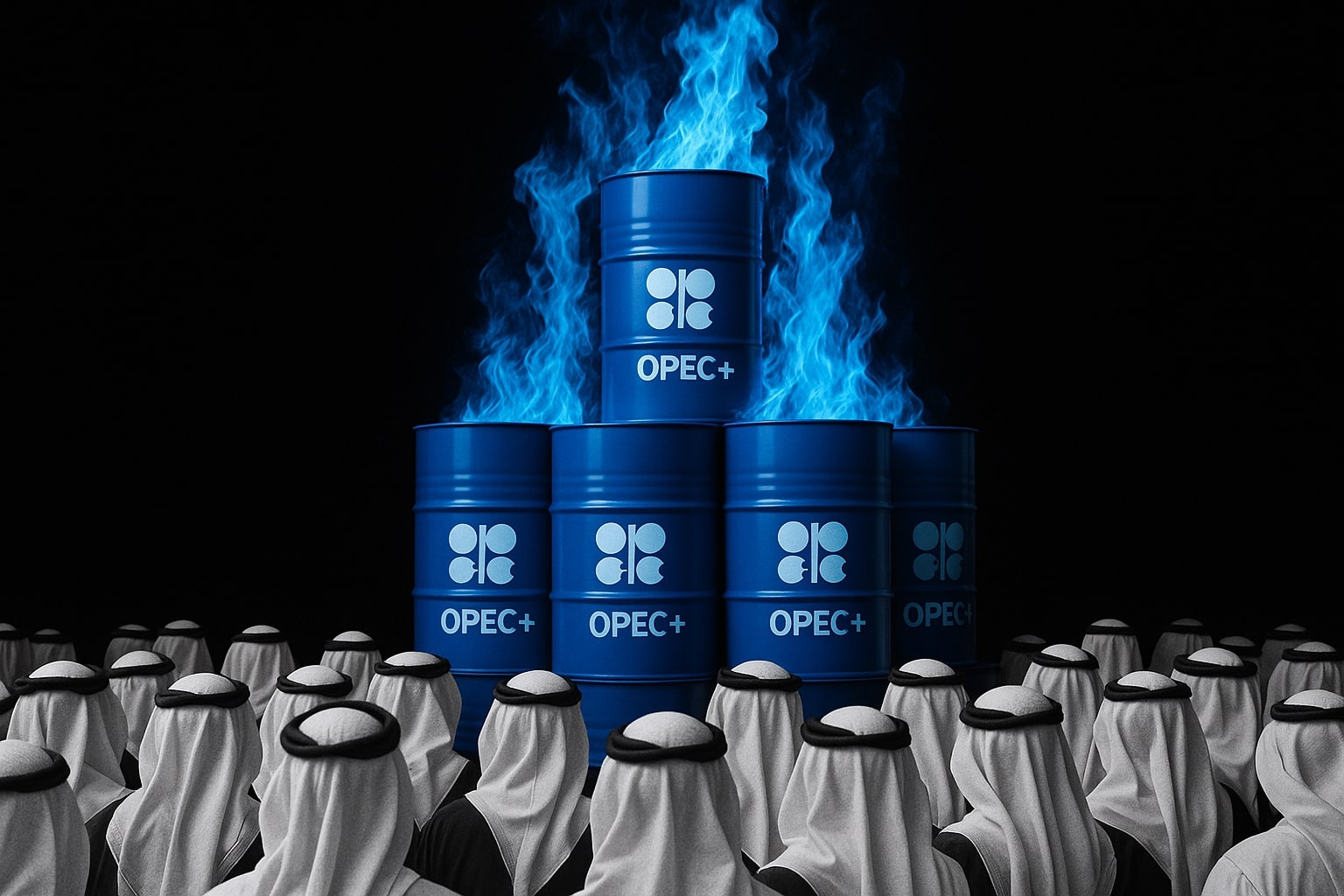
Oil Price Forecast - WTI and Brent Crude Retreat Below Key Levels as Saudi OSP Cuts
Oil trades at $59.10 WTI and $63.09 Brent, pressured by Saudi price cuts, record-high tanker costs, and oversupply warnings | That's TradingNEWS
WTI (CL=F) and Brent (BZ=F) – Crude Oil Faces Structural Downtrend as Saudi Arabia Cuts OSPs, Freight Rates Hit 5-Year High, and Global Demand Falters Below $60
The global oil market has entered a defining corrective phase, with WTI crude (CL=F) trading near $59.10, down 0.84%, and Brent (BZ=F) around $63.09, down 0.68%, as renewed fears of oversupply collide with visible demand stagnation. Every intraday attempt to reclaim the $60–$62 WTI and $65–$67 Brent resistance range fades almost instantly, revealing a pattern of exhaustion across speculative and physical markets. The sentiment shift stems directly from Saudi Arabia’s sharp December price cuts, record-high freight rates driven by sanctions dislocation, and persistent skepticism over the strength of global refining demand as inventories rise and spreads flatten.
Saudi Price Strategy: Market Share Over Price Discipline
Saudi Aramco’s latest Official Selling Price (OSP) adjustment marked the most aggressive move of 2025, reflecting a deep concern about regional demand and competitive pricing. The state giant reduced Arab Light to a premium of $1.00 per barrel above the Oman/Dubai average, down $1.20 from November levels. Heavier grades were also trimmed, with Arab Medium and Arab Heavy both cut by $1.40, to premiums of only $0.05 and $0.10 per barrel respectively. Even the premium Arab Extra Light grade saw a $1.20 reduction to $1.30 per barrel, while U.S.-bound cargoes were cut by $0.50 across all grades. Prices to Northwest Europe and the Mediterranean remained unchanged, reflecting a focus on defending Asian market share. The Saudi signal is clear—Riyadh is prioritizing volume stability over price elevation, preparing for an early-2026 period of oversupply. The decision followed the OPEC+ production adjustment that adds 137,000 barrels per day in December before pausing further hikes through the first quarter of 2026. The move confirms that the alliance’s output discipline is softening, even as demand signals weaken.
Freight and Tanker Dislocation: The Hidden Tax on Crude
Simultaneously, the shipping cost structure has erupted. Freight rates for Very Large Crude Carriers (VLCCs) from the Middle East Gulf surpassed $125,000 per day, a five-year high that effectively erases the benefit of OSP cuts for Asian refiners. The surge reflects a massive squeeze in compliant tanker availability after the U.S. Treasury’s OFAC sanctions on Rosneft and Lukoil on October 22, which affected nearly half of Russia’s crude export base. Within two weeks, European and British sanctions followed, designating another 117 ships, freezing transactions through key marine insurers, and accelerating the growth of the so-called dark fleet—older, anonymous vessels operating outside compliance systems. The result is logistical chaos. Crude-on-water volumes have reached 1.3 billion barrels, up nearly 200 million barrels in just six weeks. Approximately 54% of Russian oil exports are now moved via sanctioned or shadow tonnage, forcing compliant refiners in India, China, and South Korea to seek costlier cargoes from the Middle East and West Africa. Freight inflation has become the new equilibrium, turning shipping costs into a de facto tax on physical oil and undermining any bullish impulse.
Russian Sanctions Shockwave: India and China Step Back
The latest sanctions have forced Asian refiners to test the limits of compliance. India’s Mundra port currently holds two blacklisted tankers—the Kusto and Ailana—carrying 1.4 million barrels of Russian crude unable to discharge due to ownership restrictions and documentation risks. Indian majors such as HPCL-Mittal Energy and Indian Oil Corporation are reportedly scaling back Russian purchases, while the Nayara refinery, 49% owned by Rosneft, remains the last consistent importer of Urals crude. In China, several independent refiners have paused orders amid U.S. enforcement threats, leading to temporary storage backlogs in Shandong. The logistical paralysis, combined with increased voyage times and rerouting via ship-to-ship transfers, has trapped an additional 200 million barrels offshore—effectively tightening the available float but doing little to support headline prices, as refinery intake slows.
Brent and WTI Technical Structure: Downtrend Remains Firm
WTI’s recent technical formation shows a clean descending channel extending from the late-September peak near $70. Every rebound toward $60–$62 has met heavy selling. The next key support stands near $58.20, and a sustained break below that level exposes $56.00 and $55.50 as the next downside targets. Brent shows a similar setup, capped repeatedly by the 50-day EMA near $65, with unfilled price gaps extending toward $62.50 and $61.00. A daily close under $62.50 would confirm a bearish continuation pattern, opening a slide toward $60.00. Momentum indicators reinforce this setup—the RSI remains weak in the 40–45 range, and the MACD remains negative across both daily and weekly frames, indicating that sellers maintain control.
OPEC+ Supply and Global Balances: The Price Ceiling Hardens
The latest OPEC+ adjustment adds 137,000 barrels per day in December, bringing the cumulative increase since April to 2.9 million barrels per day, roughly 2.7% of global supply. However, the effect is uneven. Saudi Arabia continues to shoulder voluntary cuts elsewhere, but the increase from smaller members and Russia’s diversion efforts offset those reductions. Simultaneously, U.S. production remains elevated above 13.1 million barrels per day, with record Permian output stabilizing above 5.9 million barrels per day. Combined OECD inventories rose by 9.2 million barrels in October, with U.S. commercial stocks up 2.8 million barrels in the latest EIA report. The fundamental picture points to a market that is neither undersupplied nor squeezed. Each OSP cut merely reconfirms that producers are bracing for surplus in the first half of 2026.
Read More
-
Super Micro Computer Stock Price Forecast - SMCI Falls After Earnings Miss but Raises Full-Year AI Revenue Outlook
06.11.2025 · TradingNEWS ArchiveStocks
-
XRP Price Forecast - XRP-USD Holds Near $2.30 as Ripple’s $500M Raise and Mastercard Deal Redefine Its Market Path
06.11.2025 · TradingNEWS ArchiveCrypto
-
Gold Price Forecast - XAU/USD Reclaims $4,000 as Dollar Retreats, Layoffs Spike, and UBS Eyes $4,700–$5,600 Rally
06.11.2025 · TradingNEWS ArchiveCommodities
-
Stock Market Today - AI Stocks NVDA,AMD,QCOM Crash, Layoffs Spike, and Tesla’s $1 Trillion Vote Rattles Markets
06.11.2025 · TradingNEWS ArchiveMarkets
-
GBP/USD Price Forecast - Pound Holds Near 1.3060 Ahead of BoE Decision
06.11.2025 · TradingNEWS ArchiveForex
Macro and Demand Environment: The Silent Drag on Crude
While supply headlines dominate, demand destruction is quietly spreading. The U.S. Dollar Index (DXY) has weakened below 97.00, but oil has not responded positively—a classic sign of structural demand malaise. The ISM Manufacturing PMI in the U.S. slipped below 50, Europe remains in contraction, and China’s refinery runs fell by 1.8% month-over-month. Distillate cracks have softened to $17–$18 per barrel, down from $24 in September, squeezing refiners and capping run rates. The combination of weaker macro growth, softer petrochemical margins, and rising storage is flattening the forward curve. Both WTI and Brent are now flirting with mild contango, signaling a shift from scarcity to storage-led pricing.
Venezuela Factor: Potential Wildcard in Supply Psychology
An escalating standoff between the U.S. and Venezuela introduces short-term volatility but limited structural support. Intelligence and satellite tracking show the USS General Ford carrier group positioned in the Caribbean, with an operational window between November 8–30, raising the risk of a tactical strike scenario. However, even a successful coup or disruption would only remove 0.25–0.5 million barrels per day temporarily from global trade—insufficient to counterbalance global oversupply. In the medium term, Chevron and Valero Energy already hold agreements to ramp Venezuelan exports to the U.S. Gulf, potentially lifting output from 1.0 million to 1.5 million barrels per day over the next two years. The base case remains bearish: geopolitical shocks could spark a 5–8% spike, but such moves will fade quickly amid abundant supply and freight congestion.
Freight Bottlenecks and Shadow Tonnage: The Real Market Constraint
The most defining feature of this cycle is not production but transportation. Sanctioned tonnage now exceeds 500 vessels, including hundreds of older ships acquired through single-purpose Hong Kong or Seychelles entities that disguise ownership. Clean, non-sanctioned tonnage is in short supply, causing legitimate cargoes to face longer delays and higher costs. This bottleneck inflates landed costs in Asia and compresses refining margins, eroding any OSP discount benefits. In effect, the market is oversupplied with oil but undersupplied with usable ships—a paradox that keeps physical benchmarks heavy even when paper futures stabilize.
Investor Positioning and Derivatives Market: Selling Strength, Not Buying Dips
CFTC data indicates that managed money has reduced net long positions in WTI by 19% week-over-week, while open interest in Brent put options rose 22%. Option skew remains decisively bearish, with one-month risk reversals heavily favoring downside protection. Implied volatility hovers around 33%, reflecting defensive hedging rather than panic. The positioning bias aligns with systematic selling of rallies into the $60–$62 WTI / $65–$67 Brent bands, consistent with a market that perceives every uptick as temporary.
Fundamental Price Outlook and Strategic Bias
At this stage, oil is trapped between macro gravity and tactical volatility. Brent’s ceiling hardens at $67, WTI’s floor softens near $57, and freight acts as a silent drag on pricing efficiency. Refiners remain cautious, traders fade rebounds, and producers defend output share. The market will need either a genuine supply disruption or unexpected demand acceleration to escape this range. Without either, the structural signal is bearish.
TradingNews Decision: SELL RALLIES, HOLD CORE SHORTS.
Bias remains bearish as long as WTI stays below $62 and Brent below $67. The medium-term range remains $55–$62 WTI and $60–$67 Brent, with pressure favoring the lower bound.
Projected Range Through November 2025:
-
WTI (CL=F): $55.50 – $62.00
-
Brent (BZ=F): $60.00 – $66.50
Target: If freight remains elevated and OSP cuts persist, both benchmarks could test early-2024 support levels near $55 WTI and $60 Brent before any sustainable rebound emerges.



















